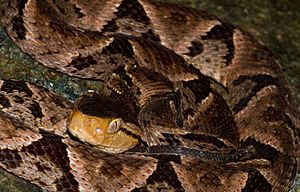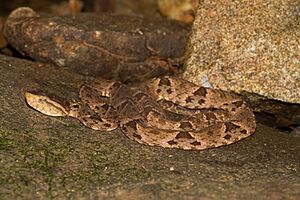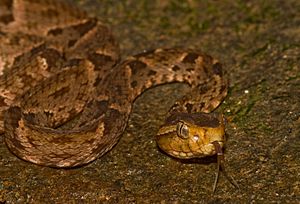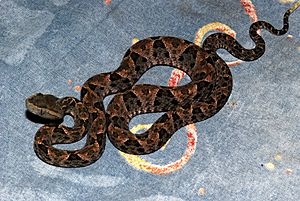Bothrops asper facts for kids
Quick facts for kids Bothrops asper |
|
|---|---|
 |
|
| Conservation status | |
| Scientific classification | |
| Genus: |
Bothrops
|
| Species: |
asper
|
 |
|
| Geographical range of Bothrops asper. | |
| Synonyms | |
|
List
B[othrops]. atrox var. dirus
Jan, 1863 Trigonocephalus xanthogrammus Cope, 1868 Trigonocephalus asper Garman, 1884 B[othrops]. atrox septentrionalis F. Müller, 1885 B[othrops]. quadriscutatus Posada Arango, 1889 Lachesis xanthogrammus – Boulenger, 1896 Bothrops xanthogramma – Amaral, 1930 Bothrops atrox asper – H.M. Smith & Taylor, 1945 Bothrops asper – Stuart, 1963 Bothrops xantogrammus – Hoge, 1966 Trigonocephalus xantogrammus – Hoge, 1966 Lachesis xantogrammus – Hoge, 1966 Bothrops xantogramma – Hoge, 1966 Bothrops asper – J. Peters & Orejas-Miranda, 1970 Bothrops xanthogrammus – J. Peters & Orejas-Miranda, 1970 Bothrops andianus asper – Mertens, 1987 Bothrops lanceolatus asper – Sandner-Montilla, 1990 Bothrops atrox xanthogrammus – Schätti & Kramer, 1993 Bothrops asper – Greene, 1997 |
|
The Terciopelo (Bothrops asper) is a large and powerful pit viper snake. It lives in warm, low-lying areas from northeast Mexico through Central America and into parts of South America. This snake can be found at elevations up to 2600 meters in the Colombian and Ecuadorian Andes mountains, and also in Venezuela.
Terciopelos are among the biggest pit vipers. They can weigh up to 6 kilograms (13 lb) and grow to 2.5 metres (8.2 ft) long. Their color ranges from light to dark brown, often with yellow zig-zag patterns on their sides. This snake is known for its size, long fangs, and strong venom. It has a reputation for being dangerous because it lives close to people and can be defensive. However, like other venomous snakes, it tries to avoid humans whenever possible. There are no different types (subspecies) of Terciopelo recognized today.
Contents
What's in a Name?
The name Bothrops comes from ancient Greek words. Bothros means 'pit', and ops means 'face' or 'eye'. This name refers to the special heat-sensing pits on the snake's face. These pits help the snake find warm-blooded prey in the dark.
The second part of its scientific name, asper, is a Latin word. It means 'rough' or 'harsh'. This might describe the snake's rough, ridged scales on its back.
Other Names for the Terciopelo
This snake has many common names depending on where it lives. Some of these names include:
- Terciopelo (meaning "velvet" in Spanish)
- Fer-de-lance
- Mapepire balsain (Trinidad)
- Carpet labaria (Guyana)
- Barba amarilla (Guatemala, Honduras, Nicaragua; meaning "yellow beard")
- Equis (Ecuador and Panama; meaning "x")
- Talla equis
- Mapaná (Colombia)
- Cuaima (Venezuela)
- Nauyaca (México; from a native language, meaning "four noses")
- Yellow-jaw tommygoff (Belize)
The name fer-de-lance is French and means "iron spear point" or "lancehead". This name is often used for many snakes in the Bothrops group. However, experts prefer to call Bothrops asper by the name 'Terciopelo'. This helps avoid confusion with other similar snakes.
How to Spot a Terciopelo
Bothrops snakes have wide, flat heads that stand out from their bodies. The Terciopelo's head can be light brown, dark brown, or even black. Sometimes, it has faint dark spots or lines on the back of its head.
The snake's belly is usually pale yellow, cream, or whitish-gray. It has dark spots that become more common towards its tail. On its sides, it has dark triangles with light edges. These triangles can be seen from 18 to 25 times along its body. The snake's back can be olive, gray, light brown, dark brown, tan, or almost black. In drier areas, these snakes have more scales to help them save water.
Female Terciopelos are much larger than males. They can weigh up to 6 kilograms (13 lb) and are often 1.2 to 1.8 meters (3.9 to 5.9 ft) long. Very large females can even reach 2.5 metres (8.2 ft), but this is rare. Both male and female snakes are born the same size. However, after about 7 to 12 months, females start growing much faster.
Females have thick, heavy bodies and much larger heads. Their fangs are also bigger, typically about 2.5 cm long. Because of these differences, it can sometimes be hard to tell them apart from other similar snakes, like Bothrops atrox.
Where Do Terciopelos Live?
The Terciopelo is found in many places. In Mexico, it lives along the Gulf-Atlantic coast, as far north as Tamaulipas. It also lives throughout the Yucatán Peninsula and south into Central America. This includes countries like Guatemala, Belize, Honduras, Nicaragua, Costa Rica, and Panama. There is also a separate group of these snakes in parts of Mexico and Guatemala.
In South America, you can find them in Colombia, Ecuador, Guyana, and Venezuela. They usually live in low-lying areas, from sea level up to about 1,200 to 1,300 meters (3,900 to 4,300 ft). However, in South America, they can be found at much higher elevations, sometimes up to 2,640 metres (8,660 ft) in Colombia. They even live on Gorgona Island off the Pacific coast of Colombia.
What Kind of Home Do They Like?
Terciopelos prefer places with a lot of moisture. They live in most low or middle elevation areas (up to 600 metres (2,000 ft)), especially those without long dry seasons. They are most common in tropical rainforests and evergreen forests.
However, they can also be found in drier areas. These include tropical deciduous forests, thorn forests, and pine savannahs. They often stay near lakes, rivers, and streams. A Terciopelo's home range is usually between 3.71 and 5.95 hectares, which is quite small for a pit viper.
How Do Terciopelos Behave?
The Terciopelo is a nocturnal snake, meaning it is active at night. It prefers to be alone. It moves less when the weather is colder or drier. You can often find these snakes near rivers and streams. During the day, they might bask in the sun. At night, they lie still, hidden in leaf litter or under forest plants. They wait to ambush prey like rats and mice that come close.
If a Terciopelo feels trapped or threatened, it can be very defensive. It might coil its body into an 'S' shape, ready to strike. Young Terciopelos often climb into bushes and low trees. Even adult snakes are sometimes seen in trees. Young snakes also use a trick called caudal luring. They wiggle their brightly colored tail tips to attract prey. Only male Terciopelos have bright tail tips.
These snakes are known to be quick and unpredictable when disturbed. They usually try to escape from danger. But if they can't, they can suddenly turn around and defend themselves strongly. Adult Terciopelos, when cornered, can be very dangerous.
What Do Terciopelos Eat?
Terciopelos eat a wide variety of animals. When they are young, they mostly eat cold-blooded animals like frogs and lizards. As they grow older, their diet changes to mostly warm-blooded animals, especially small mammals. However, both young and adult snakes will eat whatever prey they can find.
Sometimes, insects like beetles and bugs are found in their stomachs. This suggests that insects might also be a food source for them. Young Terciopelos have even been seen eating other young Terciopelos. They also eat dead frogs and rodents if they find them.
Some of the animals Terciopelos eat include:
- Cold-blooded animals: Centipedes, beetles, grasshoppers, crayfish, eels, frogs, toads, lizards, and other snakes.
- Warm-blooded animals: Different types of birds (like wrens and tanagers) and mammals (like opossums, mice, rats, porcupines, rabbits, and shrews).
How Do They Have Babies?
The Terciopelo's breeding season and the number of babies it has can change depending on the location. In Costa Rica, their breeding cycles are closely linked to the amount of rainfall.
On the Pacific side of Costa Rica, mating happens between September and November. Females give birth between April and June. On average, a female has about 18 babies, but can have anywhere from 5 to 40. The baby snakes are about 28 to 34.6 centimeters (11.0 to 13.6 in) long and weigh 6.7 to 13.1 grams (0.24 to 0.46 oz).
On the Atlantic side, mating is in March, and births happen between September and November. Here, a female has more babies, averaging about 41, but sometimes as many as 86. These baby snakes are 27 to 36.5 centimeters (10.6 to 14.4 in) long and weigh 6.1 to 20.2 grams (0.22 to 0.71 oz).
For both groups, pregnancy lasts about six to eight months. Larger females tend to have more babies. The Terciopelo is known for having more offspring than any other snake in the Americas. Females can mate with more than one male during the breeding season.
Understanding Terciopelo Venom
The Terciopelo is a major cause of snakebites in many areas where it lives. For example, in Costa Rica, it is considered the most dangerous snake. It is responsible for a large percentage of snakebites there. Thanks to places like the Clodomiro Picado Research Institute, which makes antivenom (medicine to treat snakebites), the number of deaths from these bites has greatly decreased.
Many bites happen because these snakes often live near human homes. They can even be found inside buildings. The Terciopelo is known for being irritable and moving quickly. It can also raise its head high off the ground, which means bites can happen above the knee. It has even been seen spraying venom from its fangs over a distance of at least 1.8 metres (5.9 ft).
If someone is bitten, they might feel pain and swelling. They could also have bruising, blisters, and numbness. Other effects can include a mild fever, headache, and bleeding from the nose or gums. In serious cases, the bite area might be badly damaged. It's very important to get medical help right away if bitten.
The venom of the Terciopelo is very strong. Even opossums, which are usually resistant to snake venom, can be affected by it. This strong venom might have developed to help the snakes protect themselves from predators like opossums.
Images for kids
See also
 In Spanish: Bothrops asper para niños
In Spanish: Bothrops asper para niños









